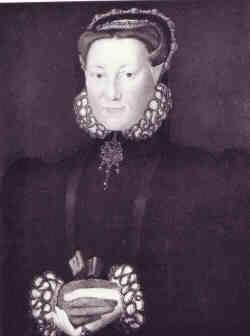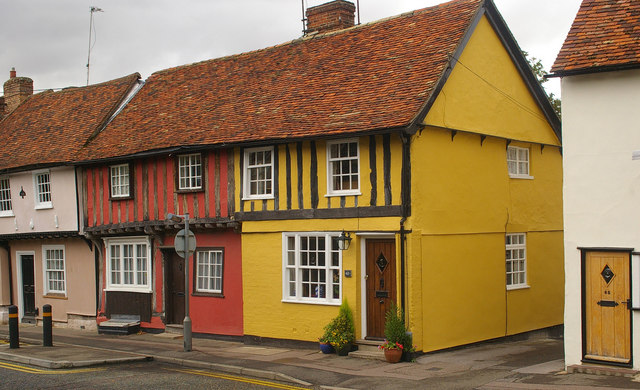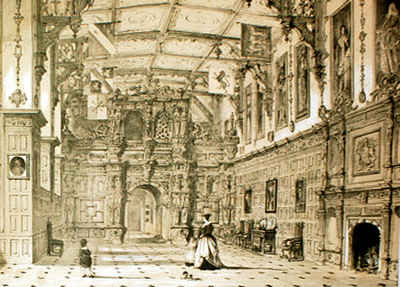|
Thomas Howard, 1st Earl Of Suffolk
Thomas Howard, 1st Earl of Suffolk, (24 August 156128 May 1626) of Audley End House in the parish of Saffron Walden in Essex, and of Suffolk House near Westminster, a member of the House of Howard, was the second son of Thomas Howard, 4th Duke of Norfolk by his second wife Margaret Audley, the daughter and eventual sole heiress of Thomas Audley, 1st Baron Audley of Walden, of Audley End. Early life and marriages After the death of his mother on 10 January 1564, the infant Thomas inherited the manor of Saffron Walden and other Audley properties. While imprisoned in the Tower before his execution in 1572, his father urged him to marry his stepsister Mary Dacre, the daughter of Thomas Dacre, 4th Baron Dacre and Elizabeth Leybourne, the Duke's third wife. He did so; but Mary died, childless, in April 1578 at Walden. In or before 1582, Howard remarried, his second wife being Katherine Knyvet, widow of Richard, son of Robert Rich, 2nd Baron Rich. A noted beauty, she was als ... [...More Info...] [...Related Items...] OR: [Wikipedia] [Google] [Baidu] |
Admiral (Royal Navy)
Admiral is a senior rank of the Royal Navy, which equates to the NATO rank code OF-9, outranked only by the rank of admiral of the fleet. Royal Navy officers holding the ranks of rear admiral, vice admiral and admiral of the fleet are sometimes considered generically to be admirals. The rank of admiral is currently the highest rank to which a serving officer in the Royal Navy can be promoted, admiral of the fleet being in abeyance except for honorary promotions of retired officers and members of the Royal Family. The equivalent rank in the British Army and Royal Marines is general; and in the Royal Air Force, it is air chief marshal. History The first admirals (1224 to 1523) King Henry III of England appointed the first known English Admiral Sir Richard de Lucy on 29 August 1224. De Lucy was followed by Sir Thomas Moulton in 1264, who also held the title of ''Keeper of the Sea and Sea Ports''. Moulton was succeeded by Sir William de Leybourne, (the son of Sir Roger de Leyb ... [...More Info...] [...Related Items...] OR: [Wikipedia] [Google] [Baidu] |
Thomas Howard, 4th Duke Of Norfolk
Thomas Howard, 4th Duke of Norfolk, ( Kenninghall, Norfolk, 10 March 1536Tower Hill, London, 2 June 1572) was an English nobleman and politician. Although from a family with strong Roman Catholic leanings, he was raised a Protestant. He was a second cousin of Queen Elizabeth I through her maternal grandmother, and held many high offices during her reign. Norfolk was the son of the poet, soldier and politician Henry Howard, Earl of Surrey. He is believed to have commissioned Thomas Tallis, probably in 1567, to compose his renowned motet in forty voice-parts, '' Spem in alium''. He was executed for his role in the Ridolfi plot. Early life, family, and religion Norfolk was born at his family's house at Kenninghall, Norfolk on March 10, 1536, being the eldest son of the Earl of Surrey and his wife Frances de Vere. His younger siblings were Jane, Henry, Katherine, and Margaret. After Surrey's execution in January 1547, their aunt, Mary Howard, Duchess of Richmond, ass ... [...More Info...] [...Related Items...] OR: [Wikipedia] [Google] [Baidu] |
Elizabeth Leyburne
Elizabeth Leyburne, Duchess of Norfolk (1536 – 4 September 1567), was a member of the English nobility. She first married Thomas Dacre, 4th Baron Dacre; following his death in 1566, she secretly married Thomas Howard, 4th Duke of Norfolk. She was his third wife. Family Elizabeth was born in 1536, the daughter of Sir James Leyburn of Cunswick, Westmorland, and his wife Helen Preston. The latter was the child of Thomas Preston and Anne Thornburgh. She had one sister, Anne, who married William Stanley, 3rd Baron Monteagle, by whom there was a daughter, Elizabeth. Several members of the Leyburne (also written as Leybourne and Leyburn) family were recusants, and James Leyburn, Elizabeth's great-nephew, was executed as "a catholic traitor" in 1583. Marriages and issue Elizabeth married twice. She married her first husband, Thomas Dacre, 4th Baron Dacre of Gilsland in 1555. The marriage produced five children: * Francis Dacre (d. an infant) * Anne Dacre (21 March 1557- 19 April 1630 ... [...More Info...] [...Related Items...] OR: [Wikipedia] [Google] [Baidu] |
Thomas Dacre, 4th Baron Dacre
Thomas Dacre, 4th Baron Dacre of Gilsland, 8th Baron Greystoke (''ca.'' 1527 – 1 July 1566) was an English Member of Parliament and after his father's death a peer and major landowner in the counties of Cumberland, Yorkshire and Northumberland. Early life Born about 1527, Dacre was the eldest of the five sons of William Dacre, 3rd Baron Dacre (''c.'' 1493 – 1563), by his marriage to Elizabeth Talbot, a daughter of George Talbot, 4th Earl of Shrewsbury and of Anne Hastings, a daughter of William Hastings, 1st Baron Hastings. His father was Captain of Norham Castle, Steward of Penrith, Warden of the West Marches 1527–1534 and 1555–1563, and Governor of Carlisle. Ferguson's ''A History of Cumberland'' notes the demise of the Dacre family which followed: After Dacre's death on 1 July 1566, his widow remarried Thomas Howard, 4th Duke of Norfolk, but she died in childbirth on 4 September 1567, so Dacre's young orphaned children were left as members of the Duke's house ... [...More Info...] [...Related Items...] OR: [Wikipedia] [Google] [Baidu] |
Tower Of London
The Tower of London, officially His Majesty's Royal Palace and Fortress of the Tower of London, is a historic castle on the north bank of the River Thames in central London. It lies within the London Borough of Tower Hamlets, which is separated from the eastern edge of the square mile of the City of London by the open space known as Tower Hill. It was founded towards the end of 1066 as part of the Norman Conquest. The White Tower, which gives the entire castle its name, was built by William the Conqueror in 1078 and was a resented symbol of oppression, inflicted upon London by the new Norman ruling class. The castle was also used as a prison from 1100 (Ranulf Flambard) until 1952 ( Kray twins), although that was not its primary purpose. A grand palace early in its history, it served as a royal residence. As a whole, the Tower is a complex of several buildings set within two concentric rings of defensive walls and a moat. There were several phases of expansion, mainly ... [...More Info...] [...Related Items...] OR: [Wikipedia] [Google] [Baidu] |
Manorialism
Manorialism, also known as the manor system or manorial system, was the method of land ownership (or "tenure") in parts of Europe, notably France and later England, during the Middle Ages. Its defining features included a large, sometimes fortified manor house in which the lord of the manor and his dependents lived and administered a rural estate, and a population of labourers who worked the surrounding land to support themselves and the lord. These labourers fulfilled their obligations with labour time or in-kind produce at first, and later by cash payment as commercial activity increased. Manorialism is sometimes included as part of the feudal system. Manorialism originated in the Roman villa system of the Late Roman Empire, and was widely practiced in medieval western Europe and parts of central Europe. An essential element of feudal society, manorialism was slowly replaced by the advent of a money-based market economy and new forms of agrarian contract. In examining the ... [...More Info...] [...Related Items...] OR: [Wikipedia] [Google] [Baidu] |
Thomas Audley, 1st Baron Audley Of Walden
Thomas Audley, 1st Baron Audley of Walden KG, PC, KS (30 April 1544), was an English barrister and judge who served as Lord Chancellor of England from 1533 to 1544. Early life Audley was born in Earls Colne, Essex, the son of Geoffrey Audley, and is believed to have studied at Buckingham College, Cambridge, now known as Magdalene College. He was educated for the law, entered the Inner Temple, was named town clerk of Colchester in 1514, and became Justice of the Peace for Essex in November 1520. Career in Parliament In 1523 Audley was returned to Parliament for Essex, and represented this constituency in subsequent Parliaments. In 1527 he was Groom of the Chamber, and became a member of Wolsey's household. On the fall of the latter in 1529, he was made Chancellor of the Duchy of Lancaster, and the same year Speaker of the House of Commons, presiding over the famous assembly styled the Reformation Parliament, which abolished the papal jurisdiction. The same year he head ... [...More Info...] [...Related Items...] OR: [Wikipedia] [Google] [Baidu] |
Westminster
Westminster is an area of Central London, part of the wider City of Westminster. The area, which extends from the River Thames to Oxford Street, has many visitor attractions and historic landmarks, including the Palace of Westminster, Buckingham Palace, Westminster Abbey, Westminster Cathedral and much of the West End shopping and entertainment district. The name ( ang, Westmynstre) originated from the informal description of the abbey church and royal peculiar of St Peter's (Westminster Abbey), west of the City of London (until the English Reformation there was also an Eastminster, near the Tower of London, in the East End of London). The abbey's origins date from between the 7th and 10th centuries, but it rose to national prominence when rebuilt by Edward the Confessor in the 11th. Westminster has been the home of England's government since about 1200, and from 1707 the Government of the United Kingdom. In 1539, it became a city. Westminster is often used ... [...More Info...] [...Related Items...] OR: [Wikipedia] [Google] [Baidu] |
Northumberland House
Northumberland House (also known as Suffolk House when owned by the Earls of Suffolk) was a large Jacobean townhouse in London, so-called because it was, for most of its history, the London residence of the Percy family, who were the Earls and later Dukes of Northumberland and one of England's richest and most prominent aristocratic dynasties for many centuries. It stood at the far western end of the Strand from around 1605 until it was demolished in 1874. In its later years it overlooked Trafalgar Square. Background In the 16th century the Strand, which connects the City of London with the royal centre of Westminster, was lined with the mansions of some of England's richest prelates and noblemen. Most of the grandest houses were on the southern side of the road and had gardens stretching down to the River Thames e.g. Durham House. Construction In around 1605 Henry Howard, 1st Earl of Northampton cleared a site at Charing Cross on the site of a convent and built him ... [...More Info...] [...Related Items...] OR: [Wikipedia] [Google] [Baidu] |
Saffron Walden
Saffron Walden is a market town in the Uttlesford district of Essex, England, north of Bishop's Stortford, south of Cambridge and north of London. It retains a rural appearance and some buildings of the medieval period. The population was 15,504 at the 2011 census. History Archaeological evidence suggests continuous settlement on or near the site of Saffron Walden from at least the Neolithic period. It is believed that a small Romano-British settlement and fort – possibly in the area round Abbey Lane – existed as an outpost of the much larger settlement of Cestreforda to the north. After the Norman invasion of 1066, a stone church was built. Walden Castle, dating from about 1140, may have been built on pre-existing fortifications. A priory, Walden Abbey, was founded under the patronage of Geoffrey de Mandeville, 1st Earl of Essex about 1136, on the site of what is now Audley End House. The abbey was separated from Walden by Holywell Field. After the dissolution of the ... [...More Info...] [...Related Items...] OR: [Wikipedia] [Google] [Baidu] |
Audley End House
Audley End House is a largely early 17th-century country house outside Saffron Walden, Essex, England. It is a prodigy house, known as one of the finest Jacobean houses in England. Audley End is now one-third of its original size, but is still large, with much to enjoy in its architectural features and varied collections. The house shares some similarities with Hatfield House, except that it is stone-clad as opposed to brick.Hadfield, J. (1970). ''The Shell Guide to England''. London: Michael Joseph. It is currently in the stewardship of English Heritage but long remained the family seat of the Barons Braybrooke, heirs to the estate of whom retain a portion of the contents of the house, the estate, and the right to repurchase as an incorporeal hereditament. Audley End railway station is named after the house. History Audley End was the site of Walden Abbey, a Benedictine monastery that was dissolved and granted to the Lord Chancellor Sir Thomas Audley in 1538 by Henr ... [...More Info...] [...Related Items...] OR: [Wikipedia] [Google] [Baidu] |
Coat Of Arms Of Sir Thomas Howard, 1st Earl Of Suffolk, KG
A coat typically is an outer garment for the upper body as worn by either gender for warmth or fashion. Coats typically have long sleeves and are open down the front and closing by means of buttons, zippers, hook-and-loop fasteners, toggles, a belt, or a combination of some of these. Other possible features include collars, shoulder straps and hoods. Etymology ''Coat'' is one of the earliest clothing category words in English, attested as far back as the early Middle Ages. (''See also'' Clothing terminology.) The Oxford English Dictionary traces ''coat'' in its modern meaning to c. 1300, when it was written ''cote'' or ''cotte''. The word coat stems from Old French and then Latin ''cottus.'' It originates from the Proto-Indo-European word for woolen clothes. An early use of ''coat'' in English is coat of mail (chainmail), a tunic-like garment of metal rings, usually knee- or mid-calf length. History The origins of the Western-style coat can be traced to the sleeved, clo ... [...More Info...] [...Related Items...] OR: [Wikipedia] [Google] [Baidu] |








